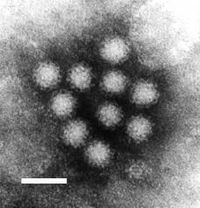
Photo from wikipedia
Supplemental Digital Content is available in the text Abstract Background: Enterovirus 71 (EV-A71) and Coxsackievirus A16 (CV-A16) are the most common causative agents causing hand, foot, and mouth disease (HFMD).… Click to show full abstract
Supplemental Digital Content is available in the text Abstract Background: Enterovirus 71 (EV-A71) and Coxsackievirus A16 (CV-A16) are the most common causative agents causing hand, foot, and mouth disease (HFMD). However, coxsackievirus A6 (CV-A6), previously largely ignored, became the predominant pathogen in China in 2012. The objective of this study is to investigate the genetic characteristics and molecular epidemiology of HFMD caused by CV-A6 to guide the diagnosis and treatment of the disease, as well as disease prevention. Material and methods: A total of 138 suspected HFMD cases were enrolled in this study and analyses based on complete VP1 nucleotide sequences were performed to determine the evolutionary trajectory of emerging CV-A6. Results: Among 138 samples in Jiujiang, 125 (90.58%) were positive for enterovirus, the most frequently presented serotypes were CV-A6 (77, 61.60%), CV-A16 (28, 22.40%), EV-A71 (6, 4.80%) and untyped enteroviruses (14, 11.20%). Seventy-seven CV-A6 positive specimens were analyzed for the complete VP1 sequences by sequencing and 36 representative isolates were selected to perform nucleotide sequence similarity analysis. The results showed that 36 strains isolated from HFMD patients were clustered closely to the mainland China and were far from prototype strain CV-A6/Gdula (AY421764) and other international subtypes. Moreover, phylogenetic analysis of the VP1 gene revealed that 36 circulating strains were not significantly concentrated in one branch, but were widely distributed in each branch. Conclusions: Continuous surveillance of HFMD etiological agents other than EV-A71 and CV-A16 is necessary. CV-A6 is emerging as the most common pathogen causing HFMD. Closely monitoring the magnitude and trend of CV-A6 epidemic and the trend of pathogenic spectrum changes can provide scientific basis for this disease prevention and control to the department of disease control.
Journal Title: Medicine
Year Published: 2019
Link to full text (if available)
Share on Social Media: Sign Up to like & get
recommendations!